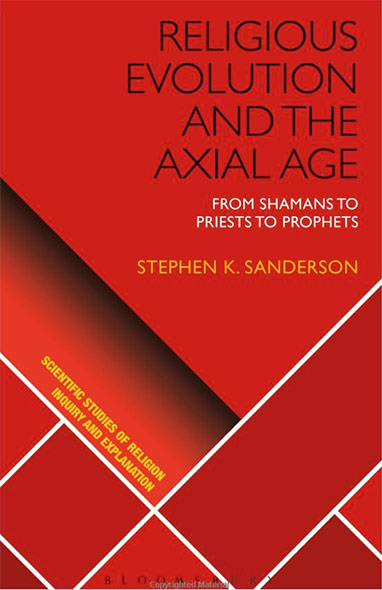Featured Book
Religious Evolution and the Axial Age
From Shamans to Priests to Prophets
Hardcover edition 2018
By Stephen K. Sanderson
Reported by Sally Mallam
Contributing Writer
Why are there are so many different types of religion and how and why has religion evolved over time? The answer lies in both our biological and our sociocultural evolution.
Some psychologists theorize that the human brain is primed for religion, but only as a by-product of its other cognitive features, the most important being those modules involved in agency detection: we are hard-wired to see, or to think we see causes even when they are not there, an adaptation that helped to keep us safe. Others contend that religious cognitions became detached from this adaptation and now stand on their own. Sanderson points out that if we were only talking about biological adaptations, then all religions would be the same. They are not, and we must look to sociocultural evolution as well as biological evolution for answers.
Wherever we look in human societies and throughout history, religion plays a part. The classical theories of Durkheim and Marx on the reasons for this are discussed as well as those of Rodney Stark and colleagues who put forward the idea that religion is about obtaining rewards, especially those that are difficult or impossible to obtain by ordinary means. Malinowski, Norris and others contend that religion’s main importance is that it serves as a source of comfort and security in an uncertain world. The approach Sanderson favors is that of the evolutionary adaptationists, ideas put forward by Sosis and Alcorta, Michael Winkelman, James McClenon and others.
This viewpoint holds that in addition to – and perhaps evolving from – the cognitive models for agency detection, our brains are innately predisposed to believe in the supernatural; this predisposition is rooted in the brain’s neural architecture especially in the prefrontal cortex, temporal lobes and limbic areas, and is activated primarily during childhood and adolescence.

Religion is adaptive in that it enhances social cohesion. When a participant is required and agrees to conform to extremes of dress, rules and rituals in order to belong to a particular religious group, it communicates to the group that the participant is highly committed. Committed participants experience such stringent requirements – known as “costly signals” – as much less of a burden than those outside the group would assume, because their experience of these costly signals actually enhances their belief and commitment which contributes to the interpersonal trust and social cohesion of the whole group.
Another viewpoint is that religion is adaptive because it decreases anxiety caused by the uncertainty of the world around us and enhances a sense of control. Joseph Bulbulia, Maclaurin Goodfellow Chair in Theological and Religious Studies at the University of Auckland, summarizes this, saying “Supernaturalisms seem to help us to endure the foxholes of life.” By decreasing this “existential stress” and providing people with important coping mechanisms, religion can promote physical health and reproductive success, where even tiny differences can have major consequences over many generations. The world’s major religions encourage reproduction and oppose infanticide and abortion unless in exceptional circumstances.

Religion of some sort has been with us for 30,000 years or more, beginning throughout the world with religious specialists known as shamans. How shamans behave is strikingly similar everywhere in the world. All seek altered states of consciousness that are trance induced. These states can be produced by hunger, thirst, loss of sleep, or other forms of sensory deprivation; by extreme forms of sensory stimulation such as drumming or dancing; or by various psychophysiological sensitivities that may result from nervous system imbalances. Once in that altered state, shamans heal people, help hunters find game animals, and solve other problems by communicating with the spirit world.
“The striking similarities in shamanic activities all over the world suggest that they are not the result of cultural diffusion, but rather of continual rediscovery and reinvention” says Winkelman in Shamanism: The Neural Ecology of Consciousness and Healing. Although not referred to by Sanderson, the reason for this similarity is found in the way the human nervous system behaves in altered states. As Clottes and Lewis-Williams’ work revealed, shamans universally operate within a three-tiered cosmos.
The existence of a so-called “shamanic syndrome” is “characterized by hypnotizability, dissociative ability, propensity for anomalous experience, fantasy proneness, temporal-lobe lability (measured by EEG), and thinness of cognitive boundaries.” Thinness of boundaries is also associated with increased potential for creativity, empathy and a sense of connectedness; and with the belief in anomalous ideas, as well as with schizotypal thought and behavior.
What is the nature of religion and how can it be defined? Sanderson gives an overview of the religions of small-scale bands and tribal societies where shamans were usually the only religious specialists, followed by the pagan polytheistic religions of the ancient world, in particular, the Aztecs of Mesoamerica, Hawaii, Mesopotamia and Rome. After a short discussion of the religious theories of the anthropologist Anthony Wallace and the sociologist Robert Bellah, Sanderson (quoting Ilkka Pyysiäinen) proposes that religion can be defined “simply as beliefs and practices devoted to supernatural agents. An agent is ‘a being that seems to have some kind of internal source of energy or force that explains its self-propelledness, that acts teleologically in pursuit of goals, and that has cognitive properties; that is, it can perceive, think, know, and remember’.”
There are three major types of religious practitioners: shamans, priests and prophets, with several minor types including diviners, disciples, magicians, missionaries and mediums. Numerous pagan religions emerged as populations grew, groups evolved, and communities formed villages and cities. These expanded as ancient civilizations evolved, along with multiple gods and a professional priesthood who replaced the shaman. The idea of treating the gods with awe most likely entered here as a reflection of the stratification of societies. Priests monopolized religious knowledge and led elaborate rituals for the whole lay community. Finally, circumstances changed, and a transcendent God was called for. The salvation religions of the Axial Age emerged.
Sanderson stresses that at each new stage of religious evolution, traces are left of the previous stage. He refers to Wallace’s four evolutionary types of religion: shamanic, communal, Olympian (polytheistic/pagan) and monotheistic, and notes that all four include shaman-like practitioners. Hebrew and other prophets of the Axial Age and later also exhibited shaman-like behavior. The sociologist Max Weber in his book Ancient Judaism noted that they “… described visual and auditory hallucinations and abnormal sensations of taste and feeling of diverse sorts. … They felt as if they were floating . . . or borne through the air, they experienced clairvoyant visions of spatially distant events like, allegedly, Ezekiel in Babylon at the hour of Jerusalem’s fall.” Moreover, “They saw hallucinatory blinding flashes of light and in it the figures of superhuman beings.”
The earliest religions of hunter-gatherer societies like the !Kung, Pawnee, or Karaja, include dreamlike myths, with mythical characters, human and animal, appearing “out of time.” At this first stage of religion there is no gap between the spirit world and our world – there is only the one world – and no separation between the specialist and society. Community members act out myths with many believing that they are the mythical characters they portray.
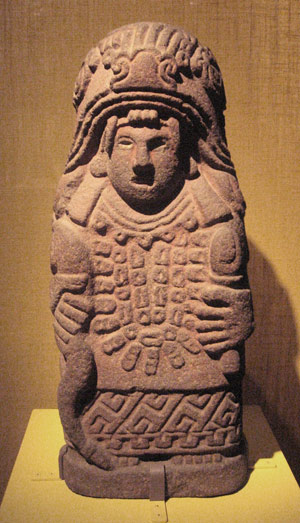
In the later primitive religions such as those practiced by Yoruba, Aztec, or Mesopotamian peoples, mythical beings are considered gods. They act willfully and rule in a hierarchical pantheon of specialized power over humans and human concerns. They are not the source of everything that exists but are derived from the preexisting order of a primordial realm, which is conceived in different ways in different religions, and they “are bound by its nature [and] subservient to its laws.” They are anthropomorphic in nature and demand worship and sacrifice, administered by a priesthood that emerges only at the very top of the social ladder, accompanied by the king and possibly selected military-political leaders.
The historic period of religion, which includes the Axial Age religions of Zoroastrianism, Judaism and Christianity among others, emerges with literacy and with writings that were considered sacred. With monotheism, God becomes more remote, and the idea emerges of a person having a moral, inner self, capable of choosing for good or bad, with an afterlife in heaven or hell. Now mankind participates in religion or is doomed, so salvation becomes the primary focus of religious concern and involves living in harmony with other people. The Axial Age prophets have a privileged relationship with God.
Sanderson goes on to say that religions have universal and variable features:
Universal Features – traits that occur in all or the vast majority of societies, such as:
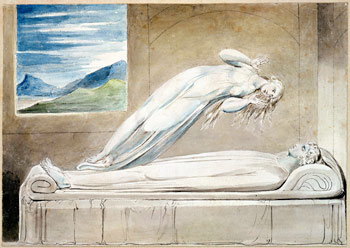
- Supernatural agents (most frequently spirits and gods)
- Good and evil supernatural agents
- Belief in souls
- Rituals
- Sacrifice
- Cosmogonies, cosmologies
- “Overworlds” (e.g., heaven) and “underworlds” (e.g., hell)
- Religious specialists
- Polluting substances
- Taboos
Variable Features – traits that occur inconsistently in societies, such as:
- Shamans, priests
- Prophets, messiahs
- Disciples, missionaries, evangelists
- Witches, sorcerers, soothsayers, mediums, diviners
- High gods, active gods, inactive gods, moralizing gods
- Trances
- Concept of afterlife
- Polytheism
- Monotheism
- Anthropomorphic gods
- Transcendent gods
- Virgin births
- World-destroying floods
- Abstract otherworldly essences
- Written doctrines
- Emotionally arousing rituals
- Animal sacrifice, human sacrifice
- Physical representation of deities (e.g., idols, graven images)
- Prayer
- Quest for the meaning of existence
- Ethical concepts
- Reincarnation
- Ascetic practices (e.g., fasting, renunciation of the material world)
- Monastic orders
- Ancestor worship

Rituals fall into the universal category and include communal rites and practices such as agricultural rites, rites of passage, and ancestor worship. Two main types of religious ritual can be distinguished, based on the degree of emotional intensity of ritual leaders and participants: imagistic and doctrinal.
Imagistic rituals involve great emotional intensity and are highly arousing. As described by Harvey Whitehouse in Modes of Religiosity: A Cognitive Theory of Religious Transmission, imagistic rituals include “traumatic and violent initiation rituals, ecstatic practices of various cults, experiences of collective possession and altered states of consciousness, and extreme rituals involving homicide or cannibalism.” These are the oldest types of rituals and are most often found in non-literate societies.
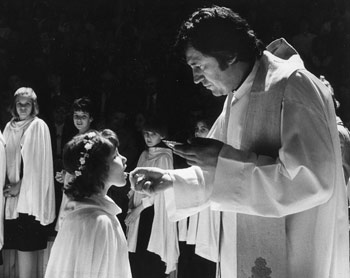
Doctrinal rituals are highly routinized and normally low in the level of emotional intensity of both leaders and participants. As a classic example, Sanderson gives the saying of mass in the Roman Catholic church. Such “doctrinal rituals” he says, “can be highly mechanical, dull, and lead to high levels of tedium. They are commonly found in more socially complex societies with literacy, and, as the name suggests, with written doctrines.”
Sanderson addresses the sociocultural evolution of religion, again examining theories by others like Darwin, Boyd and Cavalli-Sforza, Robert Carneiro and Marvin Harris. He proposes an approach called evolutionary materialism through which we can understand long-term religious evolution. In this perspective, the principal causal factors include demographic, ecological, technological and economic forces at work in the social life of any given period, affecting the material conditions of human existence. So we see that societal advances that affect population sizes, subsistence economies, the development of writing and record keeping, scientific and institutional advances and so on, are all reflected in our understanding of religion and reflect its evolution.
The author’s particular concern is the period known as the Axial Age (between about 600 BCE and 1 CE) when the major world religions emerged, bringing with them several new features, the most important of which were transcendence and salvation. “The Axial Axial Age was a time of dramatic economic and political changes that disturbed people’s lives in such a way as to lead to the disruption of social attachments and thus high levels of existential anxiety and ontological insecurity. The new Axial Age religions, with their transcendent gods and doctrines of salvation and release from misery and suffering, arose to restore people’s sense of security. As such, they were biosocial adaptations to people’s radically changed circumstances.”
Sanderson gives an overview of Axial Age religions, including Zoroastrianism, Judaism, Christianity, Confucianism, Daoism and Hinduism. He identifies five critical elements new to religion all of which emerged in the Axial Age:
- Monotheism – and with it religious intolerance, which is inherent in the very idea of One True God.
- Transcendence – God is nothing like humans. He is perfection itself – the “uncaused cause” and the “unmoved mover.” Whether the East and South Asian religions are fully transcendent is questionable, but they are certainly very different from pagan religions. Sanderson quotes Yehezkel Kaufmann, who says that in the Upanishads, for example, we “find here the conception of an eternal, supreme, impersonal being, the source of all – Brahman-Atman. This is not the creator of the world but the world itself …. It has always existed.”
- Salvation – Although earlier religions postulated an afterlife, the concept of a soul that had to be “saved” was new. Life after death was no longer a continuation of life on earth, but a radically different and positive change in which only purified souls could share.
- Increasing potential punitiveness and strictness of religious demands – Sanderson asks how we can make sense of a supernatural power that is “simultaneously compassionate and loving, on the one hand, and demanding and potentially punitive, on the other.” He refers to two ideas – one from a study by Lee Kirkpatrick which showed that children (and so presumably adults towards their gods) form stronger attachments to authoritarian and demanding parents than to less demanding ones; and another from a study by Rodney Stark showing that humans are prepared to pay higher “prices” for Gods that are dependable and show concern for their well-being by acknowledging their appeals and answering their prayers. Says Sanderson, “It is a matter of social exchange and reciprocity; the greater the rewards one party provides to another, the greater the obligations the other incurs. This is a fundamental principle of human interaction everywhere. It should be expected to apply to god-human relations just as it does to relations between humans.”
- The decline and virtual disappearance of animal sacrifice – animal sacrifice did continue, for example, in Judaism, but for different reasons, such as for the atonement for sins or in thanks.
The term Axial Age was coined by the German philosopher Karl Jaspers in Vom Ursprung und Ziel der Geschichte (The Origin and Goal of History), published in 1949, but the almost simultaneous reformation of religious ideas in so many parts of the world was noted long before. How did this happen? Sanderson looks at earlier theories and feels that while the some of these religions influenced each other, diffusion is an insufficient answer. He points out that the Silk Road was not established until about 200 BCE, so the Near East was not yet linked with either India or China. The idea that monotheism and world religions arose with, and as a consequence of, the development of cosmopolitan states and empires is also insufficient. The psychologist Bruce Lerro is one of a number who contend this. Lerro also notes that during the Iron Age, an expanded opportunity for specialization resulted in a major shift in the direction of more abstract thinking about the sacred.
Sanderson feels that the appropriate terms to describe these Axial Age religions would be ‘world transcendent’ or more particularly ‘world salvation’, since salvation is common to all. His crucial additional point is that during this period, existing religions were losing their usefulness in the face of societal changes. He lists a causal chain that lead to this transformation, a major element of which was urbanization, caused by the gradual shift from bronze to iron which had a major impact on technology. City populations grew exponentially: in 2250 BCE only 8 cities in the world had a population of 30,000 or more. By 650 BCE, some 20 cities had from 30,000 to 120,000 people each. These 20 densely populated cities (Antioch for example had 50,000 people per square mile) were all situated where the Axial Age religions first emerged. “It is extremely noteworthy,” he says, “that 62% of the population of these cities in 650 BCE lived in or around the very small region that produced Zoroastrianism, Judaism, and Christianity.”
Peoples’ customary kinship and tribal ties were broken. The uniformity and cohesion of everyday life that they relied upon for millennia was destroyed and they were suddenly forced to live among strangers, people who not only were non-kin but who were often from different ethnic groups. Trade and economic surpluses led to increased military might and increased chances of warfare, death, sickness and urban chaos. Religions could no longer satisfy the growing number of deracinated individuals for whom a sense of personal isolation was almost unbearable; they were forced to look elsewhere for safety and security. They looked outside the world for a non-human supreme and omniscient deity. Says Sanderson, “An all-powerful, loving God was an excellent prescription for people’s new sense of threat and danger.”
Sanderson quotes William McNeill who in The Rise of the West: A History of the Human Community says “Knowledge of a savior, who cared for and protected each human atom adrift in such mass communities … certainly offered men a powerful help in the face of any hardship or disaster. In addition, the religious community itself, united in a common faith and in good works, provided a vital substitute for the sort of primary community where all relations were personal, from which humankind had sprung and to which, in all probability, human instinct remains fundamentally attuned.”
Sanderson suggests that these changes were adaptive in two senses: socioculturally as we’ve noted, and, since they quite possibly led to changing gene frequencies, perhaps biologically as well. Successful religions might well lead to a disproportionate number of people with genetic predispositions to strong religiosity. More work needs to be done in this area.
Although most of the growth occurs with fundamentalist religions today, historically as religions evolve, the idea of deity becomes increasingly abstract, until in modern times we turn more to the question of meaning. We are unlikely to find out whether this was in fact the case, but Sanderson’s opinion is that “Few hunter-gatherers, horticulturalists, pastoralists, peasant farmers, or ancients merchants or craftsmen ever asked themselves the question ‘Who Am I?’ or wondered ‘What Is It All About?’ These kinds of questions reflect evolutionarily much later religious concerns.”
About the Book’s Author: Stephen K. Sanderson, Ph.D., is a specialist in sociological theory and comparative and historical sociology and was a professor of sociology at Indiana University of Pennsylvania from 1986 to 2006. Since 2015 he has been a visiting Research Associate at the Institute for Research on World-Systems at the University of California, Riverside. He is the author of numerous articles and books.
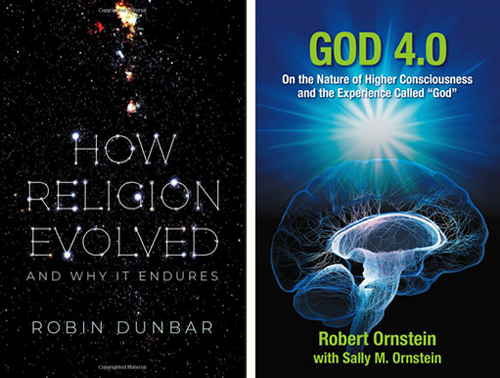
A Contemporary Look at the Nature of Religious Experience
Review by George Kasabov
Contributing Writer
People can persuade themselves of anything. Many believe that death is a transition to a transcendental world, that miracles occur through the will of God, or that our lives are ruled by immaterial spirits. How is it that, in our scientific age, when we have learned so much about the evolution of the universe and the nature of life, so many still cling to such beliefs?
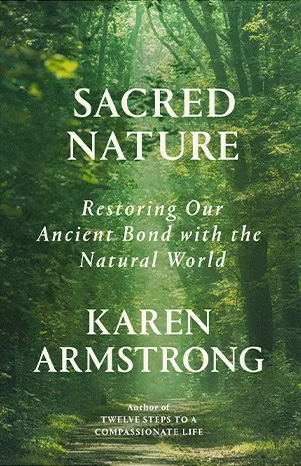
Returning to the Spirit in “Sacred Nature”
Farooq Chadhry
A review of Sacred Nature by Karen Armstrong
A staggering 33 million people have been internally displaced in Pakistan. Because climate change is likely to have played a role in the heavy rains, the displaced can be considered “climate refugees”— a term that the novelist Fatima Bhutto urges us remember, as we will all be impacted by climate change, and many of us will become migrants as a result, if we haven’t already.
In the series: Ideas that Shaped Our Modern World
Related articles:
Further Reading »
External Stories and Videos
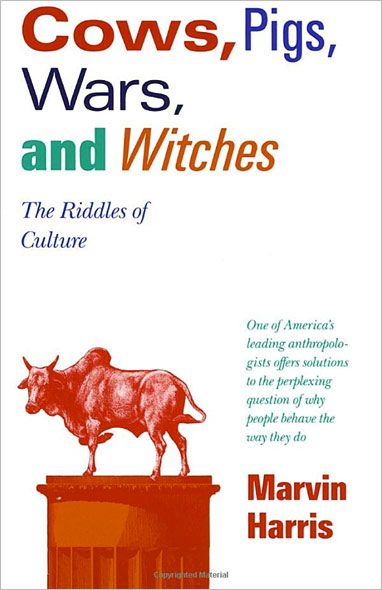
Cows, Pigs, Wars, and Witches: The Riddles of Culture
Marvin Harris
Why do Hindus worship cows? Why do Jews and Moslems refuse to eat pork? Why did so many people in post-medieval Europe believe in witches? One of America’s leading anthropologists answers these and other perplexing questions about human behavior, showing that no matter how bizarre a people’s behavior may seem, it always stems from identifiable and intelligible sources.

Our Kind: Who We Are, Where We Came From, Where We Are Going
Marvin Harris
Writing with the same wit, humor, and style of his earlier bestsellers, noted anthropologist Marvin Harris traces our roots and views our destiny.

